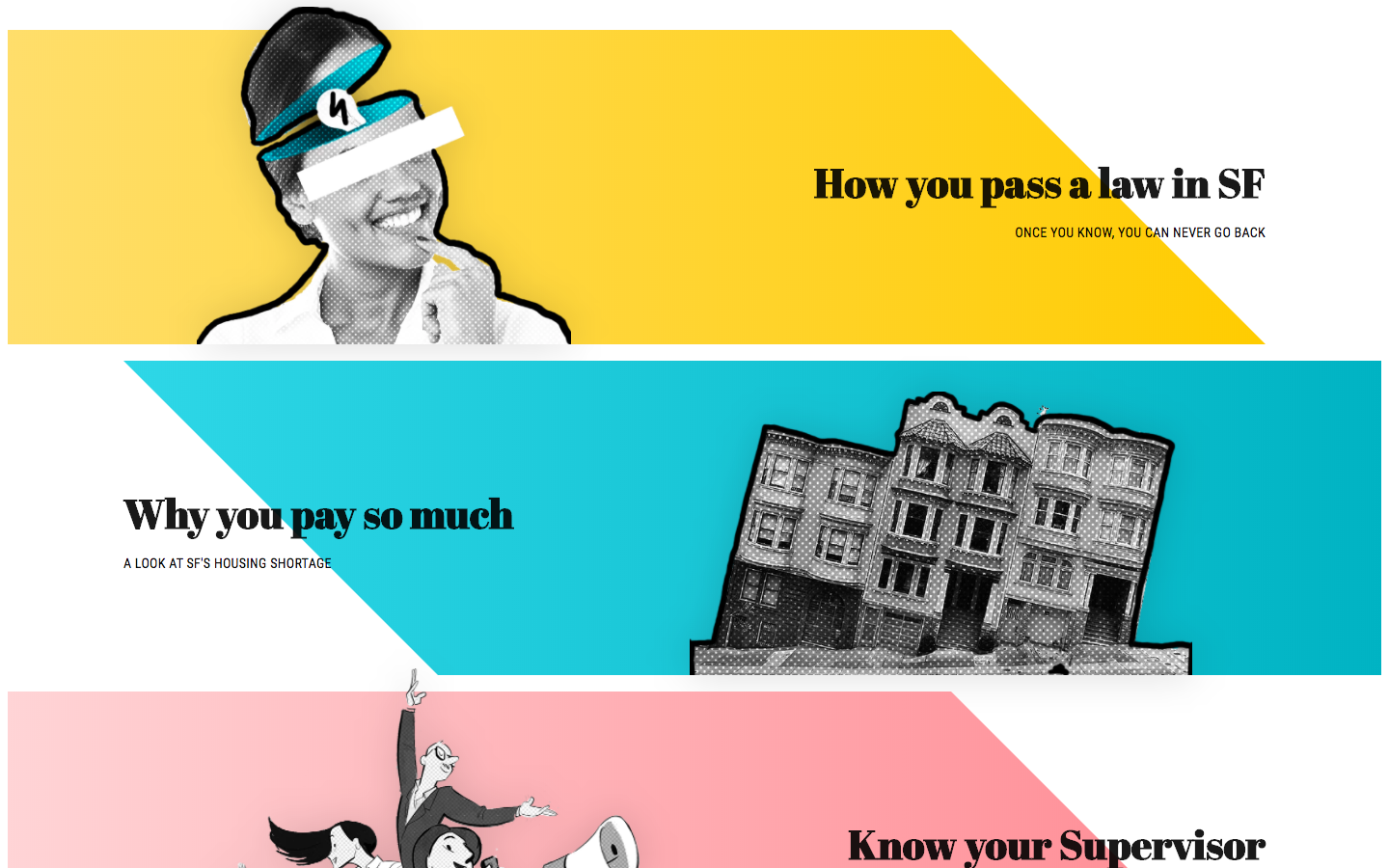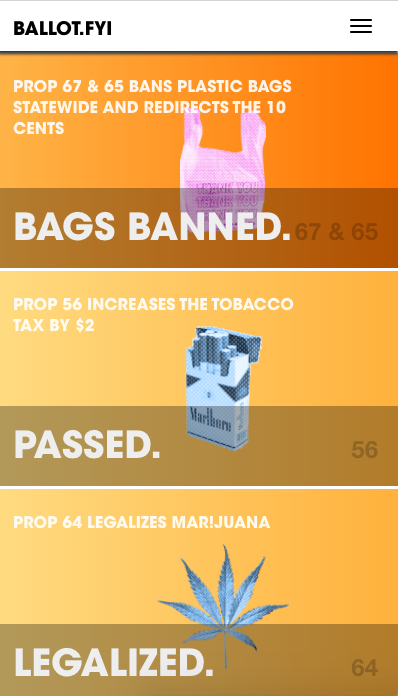
The down-ballot got you down?
Keeping up with local news is important. Participating in local politics is important. Bay Area engineer and designer Jimmy Chion felt these pressures of civic duty, but wrestled with what he felt was a shallowness to his understanding of the city he lived in, and the policies that would define it.
 “I remember certain past experiences when I voted. And when voting for president, when I got to the down-ballot stuff, I’d feel frustrated and stupid. I wanted to alleviate that for myself and for my friends,” he said. In the lead-up to the 2016 presidential election, where the national campaign was hostile but major policy changes for California were up for public vote, Chion could feel some of his friends retreating on both levels. So he created Ballot.fyi, consisting of visually entertaining, detailed explainers of the state propositions up for a vote in 2016. The site took off, receiving 20,000 to 30,000 visitors a day during October and 225,000 on Election Day alone (now also available en español). The bounce rate was high, but so were repeat visits, Chion noticed, which suggested to him that people were bookmarking the site and returning to it as a resource before heading to the polls.
“I remember certain past experiences when I voted. And when voting for president, when I got to the down-ballot stuff, I’d feel frustrated and stupid. I wanted to alleviate that for myself and for my friends,” he said. In the lead-up to the 2016 presidential election, where the national campaign was hostile but major policy changes for California were up for public vote, Chion could feel some of his friends retreating on both levels. So he created Ballot.fyi, consisting of visually entertaining, detailed explainers of the state propositions up for a vote in 2016. The site took off, receiving 20,000 to 30,000 visitors a day during October and 225,000 on Election Day alone (now also available en español). The bounce rate was high, but so were repeat visits, Chion noticed, which suggested to him that people were bookmarking the site and returning to it as a resource before heading to the polls.
These explainers are coming back for the local 2018 midterms. A new site called By the Bay, created by Chion and Yvonne Leow, is the evolved form of Ballot.fyi. By the Bay will release a ballot guide for San Jose, and bring the same editorial and design approach to other local issue explainers throughout the midterms.
“Ballot.fyi was so refreshing. It was something I could really identify with it as a young voter,” Leow said. “The way that Jimmy was framing a lot of these issues was concise, smart, but didn’t make me feel like he was ‘dumbing it down’ for me. The design really spoke to my life as well, with sections told through texts and multimedia elements like that.”
Leow, a journalist whose credits include leading Snapchat strategy for Vox and is currently president of the Asian American Journalists Association, had worked on a few post-election reckoning efforts, such as Hello Project (which sought to connect strangers with different views for a real-life conversation) and had reached out to Chion after his Ballot.fyi work.
Current local issues explainers include “How to pass a law in San Francisco” and “Why your rent is ridiculous,” a well-researched, interactive timeline of the various factors that led to the Bay Area’s housing shortage, with options to learn more, interrogate sources of information, and suggest edits, as well as a section to motivate residents to act.

Profiles of all the candidates for local office — their policy platforms and histories — are forthcoming, with an eye toward making the information memorable (Chion: “If you just read a list of platform points, who’s going to remember any of that?”). By the Bay won’t have “play-by-play” breaking news, Leow said. Instead, it will try to be “the beginning of the funnel” for locals: A voter will get to know the deeper causes of the housing shortage in the Bay Area before they have to choose among candidates with different housing policy platforms.
Chion and Leow, who are the only ones working full-time on the site, established their organization last fall as a for-profit — in part to extricate it from the foundation grant application cycle, but mostly to push themselves to think harder about making money and long-term sustainability. Their efforts are currently supported through a $15,000 grant from the Jim Bettinger Newsroom Innovation Fund and $75,000 from the Knight Foundation. (A fiscal sponsorship arrangement allows it to receive grants and donations. Also, our usual disclosure: Nieman Lab also receives Knight support.)
“As we watched news and media evolve super rapidly, one of the reasons we decided we wanted to go for-profit was that we felt our ownership was important,” Leow said. “We believe in trying to figure out the value of what we’re building. Our challenge is in trying to figure out who might be willing to pay for what we do. Everything we’re trying is around how to better serve the user. If we didn’t have those incentives as an organization, we might not be as interested in seeking that out.”
The two are currently deep into researching and writing ballot guides and candidate explainers, planning to release them in time for local primaries in June. They hope that Ballot.fyi readers will return to find similar resources, that new readers will come looking to understand upcoming midterms, and that both will stay for future guides to local issues By the Bay plans to release. Many of the future topics will be driven by the community of engaged locals it’s hoping to have helped emerge.
“My hope is many people will find us through the election. They will realize in June that they need to vote soon, they will Google information, and maybe we’ll surface there. Or they’ll see a friend share it, save it, and come back to it,” as many did with Ballot.fyi, Chion said.
By the Bay has already held meetups with San Francisco residents to hear what they want demystified about their city and how they want to be more involved. It’s also looking to form publisher partnerships; it’s currently working with public radio station KQED” for instance, on a project around an upcoming gubernatorial debate on the 19th, for which By the Bay might source video questions from its community and play them for candidates to address during the live debate. (This is purely an editorial, not financial, partnership.)
“If we can cultivate this community of conscientious, civically engaged people, we know they’re also looking for ways to take action,” Leow said. “A common complaint, especially at the local level, is, ‘I don’t know what to do about this problem!’ Maybe there’s a role we can play in terms of connecting these people with other organizations that want their help.”
The ultimate ambition is to create By the Bays in lots of other cities and offer a publishing platform where selected experts can contribute knowledge about local issues directly. At the moment, Chion and Leow are looking to hire a developer-designer and welcoming help from volunteers interested in local issues to contribute advice and ideas.
“There are young, busy professionals who understand they have a civic duty to vote and feel guilty when they aren’t as civically involved or voting in an informed way. If they don’t feel sufficiently informed, they abstain or vote down a party line,” Chion said. “We want to move the needle away from that, where the general feeling is guilt and stupidity.”